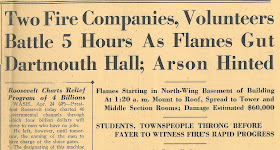 We have been moving though a very old backlog of minimally cataloged books and manuscripts. Most of them have to do with local history or Dartmouth and were in a collection called "Vault 4," a location that no longer exists except in the memories of some long-time staff members. We stumbled on a real prize this week, An Oration on Early Education. Okay, the text is a bit of a snoozer; it was one of the 1779 Dartmouth commencement addresses but was printed in "Dresden" by Alden Spooner. Spooner had been brought to Dartmouth the year before to act as printer for the College and the town. He operated his press on the south end of Dartmouth campus for a little over a year, then he moved on to Windsor, Vermont. According to Ray Nash, who compiled a bibliography of Spooner's press at Dartmouth, this was the 32nd output of the press.
We have been moving though a very old backlog of minimally cataloged books and manuscripts. Most of them have to do with local history or Dartmouth and were in a collection called "Vault 4," a location that no longer exists except in the memories of some long-time staff members. We stumbled on a real prize this week, An Oration on Early Education. Okay, the text is a bit of a snoozer; it was one of the 1779 Dartmouth commencement addresses but was printed in "Dresden" by Alden Spooner. Spooner had been brought to Dartmouth the year before to act as printer for the College and the town. He operated his press on the south end of Dartmouth campus for a little over a year, then he moved on to Windsor, Vermont. According to Ray Nash, who compiled a bibliography of Spooner's press at Dartmouth, this was the 32nd output of the press.For a long time people thought the printing press Spooner used was the actual first press brought to the colonies--the same press that printed the Bay Psalm Book. That could be true, but there is no hard evidence to support it and many historians of early American printing doubt it. We do know it was the first press brought to Vermont and the press is now on display at the Vermont Historical Society. Of course, when Spooner was printing at Dartmouth, he was technically in Vermont, or at least the folks in "Dresden" and Bennington declared it so during a territorial spat involving New York, New Hampshire, and Vermont. The campus and community flipped back to New Hampshire shortly thereafter.
To take a look at the florid prose of the Oration, ask for D.C. History LB2325.W663 1779. If you want to learn more about Spooner's press, the best place to start if Ray Nash's Pioneer Printing at Dartmouth, D.C. History Z209.H3N3.

